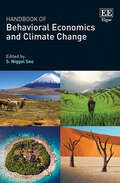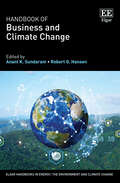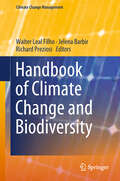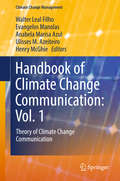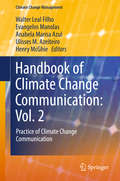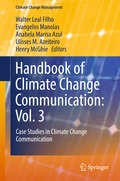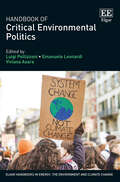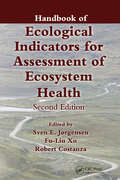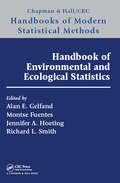- Table View
- List View
Handbook of Australasian Biogeography (CRC Biogeography Series)
by Malte C. EbachThe Handbook of Australasian Biogeography is the most comprehensive overview of the biogeography of Australasian plants, fungi and animal taxa in a single volume. This volume is unique in its coverage of marine, freshwater, terrestrial, and subterranean taxa. It is an essential publication for anyone studying or researching Australasian biogeography. The book contains biogeographic reviews of all major plant, animal and fungal groups in Australasia by experts in the field, including a strong emphasis on invertebrates, algae, fungi and subterranean taxa. It discusses how Australasia is different from the rest of the world and what other areas share its history and biota.
Handbook of Australasian Biogeography (CRC Biogeography Series)
by Malte C. EbachThe Handbook of Australasian Biogeography is the most comprehensive overview of the biogeography of Australasian plants, fungi and animal taxa in a single volume. This volume is unique in its coverage of marine, freshwater, terrestrial, and subterranean taxa. It is an essential publication for anyone studying or researching Australasian biogeography. The book contains biogeographic reviews of all major plant, animal and fungal groups in Australasia by experts in the field, including a strong emphasis on invertebrates, algae, fungi and subterranean taxa. It discusses how Australasia is different from the rest of the world and what other areas share its history and biota.
Handbook of Behavioral and Cognitive Geography
by Daniel R. MontelloThis comprehensive Handbook summarizes existing work and presents new concepts and empirical results from leading scholars in the multidisciplinary field of behavioral and cognitive geography, the study of the human mind, and activity in and concerning space, place, and environment. It provides the broadest and most inclusive coverage of the field so far, including work relevant to human geography, cartography, and geographic information science. Behavioral and cognitive geography originated as a contrast to aggregate approaches to human geography that treat people as homogenous and interchangeable; to models of human activity based on simplistic and psychologically implausible assumptions; and to conceptualizations of humans as passive responders to their environment. This Handbook is highly multi- and interdisciplinary, featuring scholars from geography, geographic information science, and more than ten other academic disciplines; including: psychology, linguistics, computer science, engineering, architecture and planning, anthropology, and neuroscience. The contributors adhere to scientific rigor in their approach, while fully engaging with issues of emotion, subjectivity, consciousness, and human variability. Thoroughly informed by the history of geography and of the cognitive sciences but also providing guideposts for future research and application, this Handbook will be an essential resource for researchers, lecturers and students in geography, psychology, and other social, behavioral, cognitive, and design sciences.
Handbook of Behavioral Economics and Climate Change
Situating a comprehensive microbehavioral analysis of the economics of climate change within a discussion of the most pressing global climate change issues and policy negotiations, the Handbook of Behavioral Economics and Climate Change is a timely collection of new research on the behaviors of economic agents that are essential to an exposition of climate change economics and policymaking.Chapters identify both microbehavioral causes of and responses to climate change by numerous economic agents, in doing so elucidating the relationship between climate policies and behavioral changes. This includes examination of individuals’ behaviors to cope with and adapt to climate change; the policy decisions aimed at altering behaviurs at individual, business, and international levels to achieve climate policy goals; and the motivations behind behaviours driven by culture, history, or religion with regards to climate change. These behaviors are contextualised within a global analysis of pressing climate change issues in land-based and ocean-based systems, including Sub-Saharan agriculture, hurricanes and sea-level rises in North America, Latin American Pampas, the small island alliance, South Asian rice agriculture, and hydroelectricity in the Himalayas.With a global scope, this Handbook will prove invaluable to students and scholars of climate change, environmental studies, and behavioral economics. With practical examples and case studies, it will also prove useful for policymakers working in climate legislation.
Handbook of Business and Climate Change (Elgar Handbooks in Energy, the Environment and Climate Change)
Summarizing the current state of knowledge on the links between business and climate change, this timely Handbook analyzes how businesses contribute to and are affected by climate change, looking closely at their centrality in developing and deploying solutions to address this problem.Contributions from a global collection of scholars and practitioners explore a broad range of key industries’ impacts and responses to climate change, examining corporate strategy and leadership in the climate economy, functional perspectives and corporate practice, and climate finance. Chapters use diverse case studies to analyze climate-related business issues, including supply chain management, decarbonization, consumer decision-making, and climate-related financial investments. The Handbook delves deeper into how businesses perceive the issue of climate change, how they are affected by and engage with it, as well as the impact they have and what this impact costs. Forward-thinking, it concludes with reflections from the contributors on what the future holds for businesses and climate change.Covering matters relating to finance, economics, marketing, operations, strategy, leadership and communications, this interdisciplinary Handbook will prove invaluable to students and scholars in business management, sustainability and environmental studies, as well as to sustainability officers (and their staff) in corporations. Addressing, as it does, a wide range of climate-related issues from the corporate standpoint, it will also prove to be a useful resource for policymakers concerned with enabling solutions to climate change.
The Handbook of Carbon Accounting
by Arnaud BrohéCarbon Accounting is a vital tool in enabling organisations to measure and report on their greenhouse gas emissions. As the need to respond to the causes and impacts of climate change becomes increasingly urgent, emissions calculations and inventories are a vital first step towards mastering climatic risk. The Handbook of Carbon Accounting offers an accessible and comprehensive presentation of the discipline. The book examines the different methods or instruments implemented by countries and companies – such as carbon taxation, carbon markets and voluntary offsetting – while revealing how these stem not simply from the aim of reducing emissions for the lowest cost, but more as a compromise between divergent interests and individual world views. It also explores the historical context of the emergence of carbon accounting, assessing its evolution since the Rio Conference in 1992 and the signing of the Kyoto Protocol in 1997, to the latest Conference of Parties in 2015 in Paris.The book concludes with a very practical guide to calculate, reduce, offset and disclose your carbon footprint.Like other management tools, carbon accounting may not be an exact science, but its contribution has never been more important. The Handbook of Carbon Accounting is a vital educational resource that will help readers – including those with no prior knowledge of the field – to understand carbon flows and stocks and to take action. It forms part of a movement that heralds the start of a new economic era in which the search for prosperity can live in harmony with the environment.
The Handbook of Carbon Accounting
by Arnaud BrohéCarbon Accounting is a vital tool in enabling organisations to measure and report on their greenhouse gas emissions. As the need to respond to the causes and impacts of climate change becomes increasingly urgent, emissions calculations and inventories are a vital first step towards mastering climatic risk. The Handbook of Carbon Accounting offers an accessible and comprehensive presentation of the discipline. The book examines the different methods or instruments implemented by countries and companies – such as carbon taxation, carbon markets and voluntary offsetting – while revealing how these stem not simply from the aim of reducing emissions for the lowest cost, but more as a compromise between divergent interests and individual world views. It also explores the historical context of the emergence of carbon accounting, assessing its evolution since the Rio Conference in 1992 and the signing of the Kyoto Protocol in 1997, to the latest Conference of Parties in 2015 in Paris.The book concludes with a very practical guide to calculate, reduce, offset and disclose your carbon footprint.Like other management tools, carbon accounting may not be an exact science, but its contribution has never been more important. The Handbook of Carbon Accounting is a vital educational resource that will help readers – including those with no prior knowledge of the field – to understand carbon flows and stocks and to take action. It forms part of a movement that heralds the start of a new economic era in which the search for prosperity can live in harmony with the environment.
Handbook of Chemical Regulations: Benchmarking, Implementation, and Engineering Concepts
by Martha J. Boss Brad Boss Cybil Boss Dennis W. DayThe first book of its kind, Handbook of Chemical Regulations: Benchmarking, Implementation, and Engineering Concepts introduces the concept of global harmonization and interlinks between regulations and examines the reasons behind major requirements for chemical manufacture, article production, and distribution, importation, and usage. A compendium
Handbook of Climate Change and Biodiversity (Climate Change Management)
by Walter Leal Filho Jelena Barbir Richard PreziosiThis book comprehensively describes essential research and projects on climate change and biodiversity. Moreover, it includes contributions on how to promote the climate agenda and biodiversity conservation at the local level. Climate change as a whole and global warming in particular are known to have a negative impact on biodiversity in three main ways. Firstly, increases in temperatures are detrimental to a number of organisms, especially those in sensitive habitats such as coral reefs and rainforests. Secondly, the pressures posed by a changing climate may lead to sets of responses in areas as varied as phenology, range and physiology of living organisms, often leading to changes in their lifecycles (especially but not only in reproduction), losses in productivity or even death. In some cases, the very survival of very sensitive species may be endangered. Thirdly, the impacts of climate change on biodiversity will be felt in the short term with regard to some species and ecosystems, but also in the medium and long term in many biomes. Indeed, if left unchecked, some of these impacts may be irreversible. Many individual governments, financial institutes and international donors are currently spending billions of dollars on projects addressing climate change and biodiversity, but with little coordination. Quite often, the emphasis is on adaptation efforts, with little emphasis on the connections between physio-ecological changes and the lifecycles and metabolisms of fauna and flora, or the influence of poor governance on biodiversity. As such, there is a recognized need to not only better understand the impacts of climate change on biodiversity, but to also identify, test and implement measures aimed at managing the many risks that climate change poses to fauna, flora and micro-organisms. In particular, the question of how to restore and protect ecosystems from the impact of climate change also has to be urgently addressed. This book was written to address this need. The respective papers explore matters related to the use of an ecosystem-based approach to increase local adaptation capacity, consider the significance of a protected areas network in preserving biodiversity in a changing northern European climate, and assess the impacts of climate change on specific species, including wild terrestrial animals. The book also presents a variety of case studies such as the Yellowstone to Yukon Conservation Initiative, the effects of climate change on the biodiversity of Aleppo pine forest in Senalba (Algeria), climate change and biodiversity response in the Niger Delta region, and the effects of forest fires on the biodiversity and the soil characteristics of tropical peatlands in Indonesia. This is a truly interdisciplinary publication, and will benefit all scholars, social movements, practitioners and members of governmental agencies engaged in research and/or executing projects on climate change and biodiversity around the world.
Handbook of Climate Change Communication: Theory of Climate Change Communication (Climate Change Management)
by Walter Leal Filho Evangelos Manolas Anabela Marisa Azul Ulisses M. Azeiteiro Henry McGhieThis comprehensive handbook provides a unique overview of the theory, methodologies and best practices in climate change communication from around the world. It fosters the exchange of information, ideas and experience gained in the execution of successful projects and initiatives, and discusses novel methodological approaches aimed at promoting a better understanding of climate change adaptation. Addressing a gap in the literature on climate change communication and pursuing an integrated approach, the handbook documents and disseminates the wealth of experience currently available in this field. Volume 1 of the handbook provides a unique description of the theoretical basis and of some of the key facts and phenomena which help in achieving a better understanding of the basis of climate change communication, providing an essential basis for successful initiatives in this complex field.
Handbook of Climate Change Communication: Practice of Climate Change Communication (Climate Change Management)
by Walter Leal Filho Evangelos Manolas Anabela Marisa Azul Ulisses M. Azeiteiro Henry McGhieThis comprehensive handbook provides a unique overview of the theory, methodologies and best practices in climate change communication from around the world. It fosters the exchange of information, ideas and experience gained in the execution of successful projects and initiatives, and discusses novel methodological approaches aimed at promoting a better understanding of climate change adaptation. Addressing a gap in the literature on climate change communication and pursuing an integrated approach, the handbook documents and disseminates the wealth of experience currently available in this field. Volume 2 of the handbook provides a unique description of the theoretical basis and of some of the key facts and phenomena which help in achieving a better understanding of the basis of climate change communication, providing an essential basis for successful initiatives in this complex field.
Handbook of Climate Change Communication: Case Studies in Climate Change Communication (Climate Change Management)
by Walter Leal Filho Evangelos Manolas Anabela Marisa Azul Ulisses M. Azeiteiro Henry McGhieThis comprehensive handbook provides a unique overview of the theory, methodologies and best practices in climate change communication from around the world. It fosters the exchange of information, ideas and experience gained in the execution of successful projects and initiatives, and discusses novel methodological approaches aimed at promoting a better understanding of climate change adaptation. Addressing a gap in the literature on climate change communication and pursuing an integrated approach, the handbook documents and disseminates the wealth of experience currently available in this field. Volume 3 of the handbook provides case studies from around the world, documenting and disseminating the wealth of experiences available.
Handbook of Climate Change Mitigation
by Wei-Yin Chen, John Seiner, Toshio Suzuki and Maximilian LacknerHandbook of Climate Services (Climate Change Management)
by Walter Leal Filho Daniela JacobThis book explores climate services, including projections, descriptive information, analyses, assessments, and an overview of current trends. Due to the pressures now being put on the world’s climate, it is vital to gather and share reliable climate observation and projection data, which may be tailored for use by different groups. In other words, it is essential to offer climate services. But despite the growth in the use of these services, there are very few specialist publications on this topic. This book addresses that need. Apart from presenting studies and the results of research projects, the book also offers an overview of the wide range of means available for providing and using climate services. In addition, it features case studies that provide illustrative and inspiring examples of how climate services can be optimally deployed.
Handbook of Critical Environmental Politics (Elgar Handbooks in Energy, the Environment and Climate Change)
This timely Handbook offers a comprehensive outlook on global environmental politics, providing readers with an up-to-date view of a field of ever-increasing academic and public significance. Its critical perspective interrogates what is taken for granted in current institutions and social and power relations, highlighting the issues preventing meaningful change in the relationship between human societies and their biophysical underpinnings.Featuring contributions from over 60 established and emerging international scholars, the Handbook is organized into six thematic sections. It addresses theoretical approaches, contested notions, key issues, governance processes, mobilizations and emergent directions of inquiry, presenting a vital contemporary analysis of the major social science and political ecology debates over environmental questions.Scholars and students in the social sciences, in particular those studying politics and public policy, with an interest in the environment and climate change will find this Handbook to be essential reading. It will also be useful to academics in other disciplines related to ecology and environmental politics, as well as politicians and practitioners involved in green transition policies.
Handbook of Disaster Risk Reduction for Resilience: New Frameworks for Building Resilience to Disasters
by Saeid Eslamian Faezeh EslamianThis book is part of a six-volume series on Disaster Risk Reduction and Resilience. The series aims to fill in gaps in theory and practice in the Sendai Framework, and provides additional resources, methodologies and communication strategies to enhance the plan for action and targets proposed by the Sendai Framework. The series will appeal to a broad range of researchers, academics, students, policy makers and practitioners in engineering, environmental science and geography, geoscience, emergency management, finance, community adaptation, atmospheric science and information technology. This volume discusses how to measure and build disaster resilience at society’s capacity, drawing upon individual, institutional and collective resources to cope with and adapt to the demands and challenges of natural disaster occurrences. The book will serve as a guide, outlining the key indicators of disaster resilience in urban and rural settings, and the resources and strategies needed to build resilient communities in accordance with the targets of the Sendai Framework. Readers will learn about multi-risk reduction approaches using computational methods, data mining techniques, and System Thinking at various scales, as well as institutional and infrastructure resilience strategies based on several case studies.
Handbook of Ecological Indicators for Assessment of Ecosystem Health
by Sven Jørgensen Liu Xu Robert CostanzaContinuing in the tradition of its bestselling predecessor, the Handbook of Ecological Indicators for Assessment of Ecosystem Health, Second Edition brings together world-class editors and contributors who have been at the forefront of ecosystem health assessment research for decades, to provide a sound approach to environmental management and sust
Handbook of Ecological Indicators for Assessment of Ecosystem Health (Applied Ecology And Environmental Management Ser. #1)
by Sven E. Jørgensen; Fu-Liu Xu; Robert CostanzaContinuing in the tradition of its bestselling predecessor, the Handbook of Ecological Indicators for Assessment of Ecosystem Health, Second Edition brings together world-class editors and contributors who have been at the forefront of ecosystem health assessment research for decades, to provide a sound approach to environmental management and sust
Handbook of Energy Politics
by Jennifer I. ConsidineAssessing a rapidly changing landscape, this Handbook explores how the scope and complexity of energy politics increases constantly with the rise of new technologies, cyber security threats and environmental concerns. Starting with the fundamentals, the Handbook of Energy Politics covers the evolution of capital and financial markets in the energy industry, as well as assessing the effects of technology and environmental issues such as global warming and geopolitical tensions. It is shown that a lack of consensus on basic definitions and clear long-term goals on climate and energy are hampering the sector’s ability to invest in low-carbon growth. The importance of achieving and maintaining positive relationships for effective consultation and engagement with those directly affected by energy politics is emphasized, with a focus on factors critical for sustainable development. The authors also assess what we can learn from historical cases and the steps we can take to mitigate potential energy risks in the future. This Handbook will be an invaluable resource for upper level graduates and postgraduates of public policy and environmental politics. Policy-makers, at state, regional and local levels will benefit from the suggestions for future developments.
Handbook of Environmental Analysis: Chemical Pollutants in Air, Water, Soil, and Solid Wastes, Third Edition
by Pradyot PatnaikThe Handbook will cover all aspects of environmental analysis and will examine the emergence of many new classes of pollutants in recent years. It will provide information on an array of topics from instrumentation, analytical techniques, and sample preparations to statistical calculations, chemical structures, and equations. It will present the tools and techniques required to measure a wide range of toxic pollutants in our environment. It will be fully revised throughout, and will add four new chapters (Microbial Analysis, Chlorophyll, Chlorine, Chloramines and Chlorine Dioxide, and Derivatization Reactions in Environmental Analysis).
Handbook of Environmental Analysis: Chemical Pollutants in Air, Water, Soil, and Solid Wastes, Third Edition
by Pradyot PatnaikThe Handbook will cover all aspects of environmental analysis and will examine the emergence of many new classes of pollutants in recent years. It will provide information on an array of topics from instrumentation, analytical techniques, and sample preparations to statistical calculations, chemical structures, and equations. It will present the tools and techniques required to measure a wide range of toxic pollutants in our environment. It will be fully revised throughout, and will add four new chapters (Microbial Analysis, Chlorophyll, Chlorine, Chloramines and Chlorine Dioxide, and Derivatization Reactions in Environmental Analysis).
Handbook of Environmental and Ecological Statistics (ISSN)
by Alan Gelfand; Montse Fuentes; Jennifer A. Hoeting; Richard L. SmithThis handbook focuses on the enormous literature applying statistical methodology and modelling to environmental and ecological processes. The 21st century statistics community has become increasingly interdisciplinary, bringing a large collection of modern tools to all areas of application in environmental processes. In addition, the environmental community has substantially increased its scope of data collection including observational data, satellite-derived data, and computer model output. The resultant impact in this latter community has been substantial; no longer are simple regression and analysis of variance methods adequate. The contribution of this handbook is to assemble a state-of-the-art view of this interface. Features: An internationally regarded editorial team. A distinguished collection of contributors. A thoroughly contemporary treatment of a substantial interdisciplinary interface. Written to engage both statisticians as well as quantitative environmental researchers. 34 chapters covering methodology, ecological processes, environmental exposure, and statistical methods in climate science.
Handbook of Environmental and Ecological Statistics (ISSN)
by Alan E. Gelfand Montserrat Fuentes Jennifer A. Hoeting Richard Lyttleton SmithThis handbook focuses on the enormous literature applying statistical methodology and modelling to environmental and ecological processes. The 21st century statistics community has become increasingly interdisciplinary, bringing a large collection of modern tools to all areas of application in environmental processes. In addition, the environmental community has substantially increased its scope of data collection including observational data, satellite-derived data, and computer model output. The resultant impact in this latter community has been substantial; no longer are simple regression and analysis of variance methods adequate. The contribution of this handbook is to assemble a state-of-the-art view of this interface. Features: An internationally regarded editorial team. A distinguished collection of contributors. A thoroughly contemporary treatment of a substantial interdisciplinary interface. Written to engage both statisticians as well as quantitative environmental researchers. 34 chapters covering methodology, ecological processes, environmental exposure, and statistical methods in climate science.
Handbook of Environmental Contaminants: A Guide for Site Assessment
by Chris ShineldeckerHandbook of Environmental Contaminants: A Guide for Site Assessment is an indispensable working reference for environmental assessment professionals faced with determining potential environmental contaminants that might be found in the soil, groundwater, or air of a property or facility. The book provides a comprehensive listing of potential contaminants associated with hundreds of industries, activities, and processes. The types of properties covered range from agricultural to heavy industrial. The products and processes covered range from the processing of yeast to the constituents of rocket fuel. The book also discusses products associated with the degradation of common chemical solvents in the environment.Handbook of Environmental Contaminants: A Guide for Site Assessment is an important reference for environmental consultants, workers on Superfund sites, public health and safety professionals, attorneys, educators and students, and lenders.


